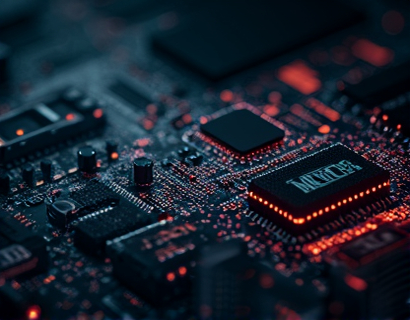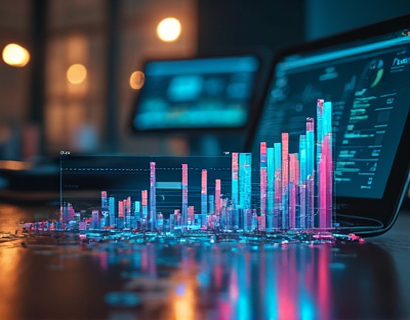Next-Gen Smart Contract AMMs: Revolutionizing DeFi Trading with Advanced Automation and Liquidity Management
The decentralized finance (DeFi) ecosystem has witnessed unprecedented growth and innovation, with smart contract-based Automated Market Makers (AMMs) emerging as a pivotal component. These AMMs leverage advanced automation and liquidity management to redefine the trading experience in the crypto space. This article delves into the cutting-edge technology behind next-generation smart contract AMMs, exploring how they optimize liquidity management and automate trading strategies to ensure seamless and efficient market interactions for crypto traders and DeFi enthusiasts.
The traditional AMM model, while revolutionary in its own right, has certain limitations that next-gen AMMs aim to address. The core mechanism of a standard AMM involves a liquidity pool where users deposit tokens to create a pool, and trades are executed based on a predefined formula that maintains the pool's balance. However, this approach can lead to issues such as impermanent loss, where liquidity providers may lose value compared to holding the tokens directly, and limited liquidity during high-volatility periods.
Next-generation smart contract AMMs introduce advanced algorithms and protocols to mitigate these issues. One significant improvement is the implementation of dynamic liquidity provision, which adjusts the liquidity pool's composition in real-time based on market conditions. This dynamic approach ensures that the AMM remains liquid and responsive, even during periods of high market volatility, thereby reducing the risk of impermanent loss and enhancing user trust.
Another key feature of advanced AMMs is the integration of machine learning and predictive analytics. These technologies enable the AMM to forecast market trends and adjust trading strategies accordingly. By analyzing historical data and real-time market signals, the AMM can optimize order execution, minimize slippage, and maximize returns for users. This level of automation not only enhances the trading experience but also attracts a broader range of users, from novice traders to seasoned DeFi enthusiasts.
Liquidity management is a critical aspect of any AMM, and next-gen solutions offer sophisticated tools to manage liquidity more effectively. One such tool is the liquidity provision incentive mechanism, which rewards users for contributing to liquidity pools. These incentives can be in the form of native tokens, staking rewards, or other forms of compensation that align with the AMM's goals. By incentivizing liquidity provision, these AMMs ensure a steady flow of funds, which is essential for maintaining low bid-ask spreads and high trading efficiency.
Furthermore, advanced AMMs incorporate multi-asset liquidity pools, allowing users to deposit and trade multiple tokens within a single pool. This feature enhances the versatility of the platform, catering to a wider range of trading strategies and use cases. For instance, a user can simultaneously trade Ethereum, Binance Coin, and a decentralized stablecoin within the same pool, streamlining the trading process and reducing the need to switch between multiple pools.
Smart contract security is paramount in the DeFi space, and next-gen AMMs prioritize this aspect through rigorous auditing and best practices. These AMMs undergo thorough security audits by reputable firms to identify and mitigate potential vulnerabilities. Additionally, they employ advanced cryptographic techniques and decentralized governance models to ensure the integrity and transparency of the platform. This commitment to security fosters confidence among users, encouraging greater adoption and participation.
The automation of trading strategies is another hallmark of next-generation AMMs. By integrating automated trading bots and algorithmic trading protocols, these platforms enable users to execute complex trading strategies with minimal manual intervention. Users can set up rules-based trading algorithms that automatically enter and exit positions based on predefined conditions, such as price thresholds, moving averages, or relative strength index (RSI) levels. This level of automation not only saves time but also reduces emotional decision-making, leading to more consistent and profitable trading outcomes.
One of the most innovative features of advanced AMMs is the incorporation of yield farming and composite strategies. Yield farming involves strategically deploying assets across various DeFi protocols to maximize returns. Next-gen AMMs facilitate this process by allowing users to seamlessly integrate their liquidity provision with yield farming opportunities. For example, a user can deposit tokens into an AMM liquidity pool and simultaneously participate in a yield farming program, earning passive income from both liquidity provision and yield farming rewards.
Composite strategies take this a step further by combining multiple DeFi protocols and AMMs into a cohesive trading workflow. Users can create custom strategies that leverage multiple AMMs, lending platforms, and decentralized exchanges (DEXs) to optimize their returns. For instance, a user might borrow a token from a lending protocol, use it to trade in an AMM, and then lock the profits back into another AMM for yield farming. This multi-faceted approach maximizes the potential returns and diversifies risk, making the trading experience more robust and rewarding.
The user interface and experience (UI/UX) of next-gen AMMs are designed to be intuitive and user-friendly, catering to both technical and non-technical users. These platforms often feature clear and concise dashboards that provide real-time insights into liquidity positions, trading history, and portfolio performance. Interactive charts and graphs help users visualize market trends and make informed decisions. Additionally, step-by-step guides and educational resources are provided to help new users navigate the platform and understand the underlying concepts.
Interoperability is another critical feature of advanced AMMs, enabling seamless interactions across different blockchain networks and DeFi protocols. By supporting multiple blockchains, these AMMs allow users to access a broader range of assets and liquidity sources, enhancing the overall trading experience. For example, a user can deposit Ethereum-based tokens into an AMM on Ethereum and simultaneously interact with AMMs on Binance Smart Chain or Polygon, expanding their trading opportunities and maximizing liquidity across ecosystems.
The integration of oracles and real-time data feeds is essential for the accuracy and reliability of next-gen AMMs. Oracles provide external data to smart contracts, ensuring that the AMM has access to up-to-date market information. This is particularly important for price feeds, which are crucial for determining trade execution prices and maintaining fair market conditions. By using trusted and decentralized oracles, AMMs can minimize the risk of price manipulation and ensure that trades are executed at accurate and competitive prices.
Scalability is a ongoing challenge in the DeFi space, and next-gen AMMs address this through layer 2 solutions and optimized smart contract design. By leveraging rollups, sidechains, and other scalability protocols, these AMMs can handle a higher volume of transactions with lower gas fees and faster confirmation times. This scalability ensures that the platform remains accessible and cost-effective, even during peak usage periods, thereby attracting a wider user base.
Lastly, community engagement and decentralized governance play a vital role in the development and success of next-gen AMMs. These platforms often have active communities that contribute to protocol upgrades, bug bounties, and governance proposals. By involving the community in decision-making processes, these AMMs foster a sense of ownership and collaboration, leading to more resilient and user-centric solutions.
In conclusion, next-generation smart contract AMMs are revolutionizing the DeFi trading landscape by introducing advanced automation, sophisticated liquidity management, and innovative trading strategies. These platforms not only address the limitations of traditional AMMs but also enhance the overall trading experience for crypto traders and DeFi enthusiasts. As the DeFi ecosystem continues to evolve, these advanced AMMs will play a crucial role in shaping the future of decentralized finance.











































